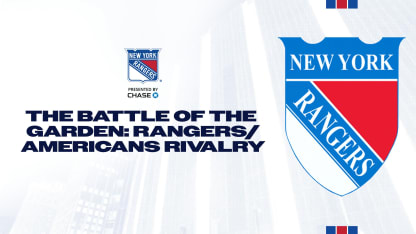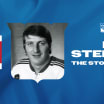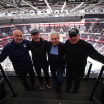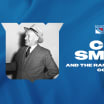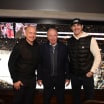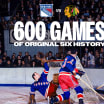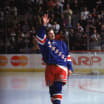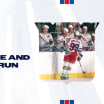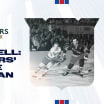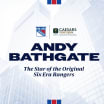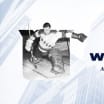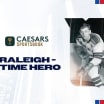Throughout the 2023-24 season, the Rangers’ website will feature a series of articles dedicated to the 25 seasons of the Original Six era from 1942-43 to 1966-67, focusing on some of the best players, moments, and teams the Rangers had in those years. Prior to the start of that series, this article details a rivalry that the Rangers had with their Madison Square Garden co-tenants, the New York Americans, over the first 16 seasons of franchise history and before the Original Six era began.
The Rangers have developed rivalries with several teams over the course of their history. Whether it has been the Islanders over the last half a century, the Devils over the last four decades, the Flyers since expansion, or the Bruins – the Rangers’ biggest rival in the Original Six era and the team the Blueshirts have played more games against than anyone else in franchise history – the battles that the Rangers have had with their biggest rivals helped shape their history and created some of their most iconic moments.
None of those teams have ever called Madison Square Garden their permanent home (the Flyers played one home game at MSG in 1967-68 due to damage at The Spectrum). The same cannot be said, however, for a team that entered the NHL prior to the Rangers, helped the Rangers franchise come into existence, and evolved into the Rangers’ biggest rival during the Blueshirts’ first 16 seasons – the New York Americans.
“The best way to describe the rivalry between the Rangers and Americans would be saying that the Americans were like the lunch pail team, and the Rangers were the aristocrats,” hockey historian Stan Fischler said. “This was a perfect rivalry.”
In September of 1925, the Hamilton Tigers – a franchise that had been playing in the NHL from 1919-20 through 1924-25 (first as the Quebec Bulldogs before moving to Hamilton) was sold to William “Big Bill” Dwyer, who was one of the biggest bootleggers of the era. William J. “Bill” MacBeth, a prominent sportswriter in the New York area, was from Canada and a proponent of bringing hockey to New York, and it was in large part due to MacBeth’s urging that Dwyer pursued acquiring the Hamilton franchise.
The remaining hurdle that needed to be cleared was convincing Tex Rickard, the owner of the soon-to-be-completed Madison Square Garden on Eighth Avenue between 49th Street and 50th Street, that having a hockey team would be profitable for the new venue. Dwyer, along with his one of his partners, Thomas Duggan, helped sell Rickard on the game.
After seeing a game live in Montreal, Rickard was hooked on hockey and was willing to provide MSG to the Americans for their inaugural 1925-26 season. Although the Americans didn’t have a winning record in their first season, they consistently drew large crowds. The Americans’ success at the box office led management at The Garden – particularly MSG vice president Col. John S. Hammond – to consider the possibility of MSG having a team of its own that could also play at the venue and create a rivalry with the Americans that was the equivalent of the Brooklyn Dodgers-New York Giants rivalry in baseball.
Rickard agreed with Hammond’s assessment, and with this idea in mind, Hammond resigned his post as President of the Americans in February of 1926 in order to focus on securing a second NHL franchise in New York. Ultimately, the Rangers were awarded a franchise to begin play in 1926-27, and the natural rivalry between the MSG co-tenants was born.
“The Rangers were challenged in dealing with the Americans during their first season,” Fischler said. “The Americans already had a fan base (from their first season in 1925-26). In order to meet (their level) and beat them, the Rangers had to have a better team.
The first way the Rangers differentiated themselves from the Americans was through their uniform. The Americans’ jersey featured the stars and stripes of the American flag, and the team name was featured horizontally across the front. By contrast, the Rangers’ jersey was solid blue, with “Rangers” positioned diagonally down the front. This led to the Rangers’ nickname – the “Blueshirts” – as well.
The second way the teams were different was their collective personality.
“The Rangers had to have a more disciplined team than the Americans (on and off the ice), and they were,” Fischler said. “The Americans were totally undisciplined, and Lester Patrick was a disciplinarian. So, right off the bat, there was a major cultural difference. The Rangers were the class team.”
While the Americans failed to make the playoffs in 1926-27 and 1927-28, the Rangers had two successful seasons. The Blueshirts won the American Division in their inaugural season in 1926-27, as captain Bill Cook led the NHL with 33 goals and 37 points, and then in 1927-28, the Rangers won their first Stanley Cup.
The Rangers’ near-instant success on the ice led several new hockey fans, who had first started watching the sport when the Americans began in 1925-26, to start cheering for the Rangers, which only added to the rivalry. In 1928-29, the Americans made the playoffs for the first time, and their reward was facing the defending Stanley Cup Champion Rangers in a two-game, total-goals Quarterfinals series.
The Rangers and Americans played opposite styles in 1928-29; although offense across the league was limited (especially by today’s standards), the Rangers were tied for third in the 10-team league in goals scored, while the Americans ranked eighth. The Americans, however, allowed the third-fewest goals in the league and were led by goaltender Roy “Shrimp” Worters, who won the Hart Trophy that season as the league’s Most Valuable Player.
Neither team scored a goal in Game 1 of the two-game series as the contest ended in a tie, setting up a winner-take-all Game 2. Again, through the first 60 minutes of Game 2, neither team scored a goal. The pressure was on Worters and Rangers goaltender John Ross Roach – who each had 13 shutouts during the 44-game regular season in 1928-29 – to not be the goaltender to allow the only goal of the series.
The first overtime period was 10 minutes in length, and neither team scored in those 10 minutes. In the second overtime period, both the Rangers and Americans believed they had scored to win the game, only to have their goals disallowed for offside. After the Americans’ goal was disallowed, the game had to be stopped in order to remove hundreds of tin whistles and rattles that had been thrown on the ice by the Americans’ fans.
The game ended as time wound down in the second overtime. Butch Keeling, who had only scored six goals in 43 regular season games in his first season with the Rangers that year, took a pass from Paul Thompson and beat Worters while crashing the net to give the Blueshirts a 1-0 win and send them to the Semifinals.
The only other year the two rivals faced each other in the playoffs was in 1937-38, when the Rangers and Americans squared off in a best-of-three Quarterfinals series. Each game was decided by one goal, and two of the three contests – including the winner-take-all Game 3 – were decided in overtime. Game 3 was tied after regulation…and the first overtime period…and the second overtime period…and the third overtime period.
Finally, 40 seconds into the fourth overtime period and at 1:30 in the morning – in what was the longest hockey game ever played in Madison Square Garden and in New York – the Americans’ Lorne Carr scored the game-winning goal.
Over the next few seasons, it became more and more evident that the Americans were falling on hard times financially. In addition, their fan base was not growing at the same rate as that of the Rangers, who despite the loss to the Americans in 1937-38, reached the Stanley Cup Final three times in the 1930s – winning the Cup in 1932-33 – and then won the Stanley Cup for the third time in franchise history in 1939-40.
Despite the discrepancy in the teams’ records and position in the standings, every game between the Rangers and Americans held special meaning. Beginning with the 1937-38 season, after MacBeth passed away, the William J. MacBeth Trophy was established and presented to whichever team won the most games in the head-to-head matchups between the Rangers and Americans in a given season. The Rangers won the Trophy for five consecutive seasons from its inception in 1937-38 through 1941-42.
Prior to the 1941-42 season, Americans general manager and head coach Red Dutton renamed the team the Brooklyn Americans, even though they still played their home games at MSG. After the season, several teams – including the Rangers – lost players off their roster as they went to serve their countries in World War II.
The Americans, in a difficult position financially and unable to replenish their roster (they only had four players from the 1941-42 team that were available to play the following season), suspended operations, leaving the NHL with six teams (the Original Six).
In 16 seasons, the Rangers and Americans played a total of 99 games against each other (94 regular season games and five playoff contests). Each one, regardless of where either team was in the standings, provided some of the most intense hockey the Blueshirts have played in their history.

